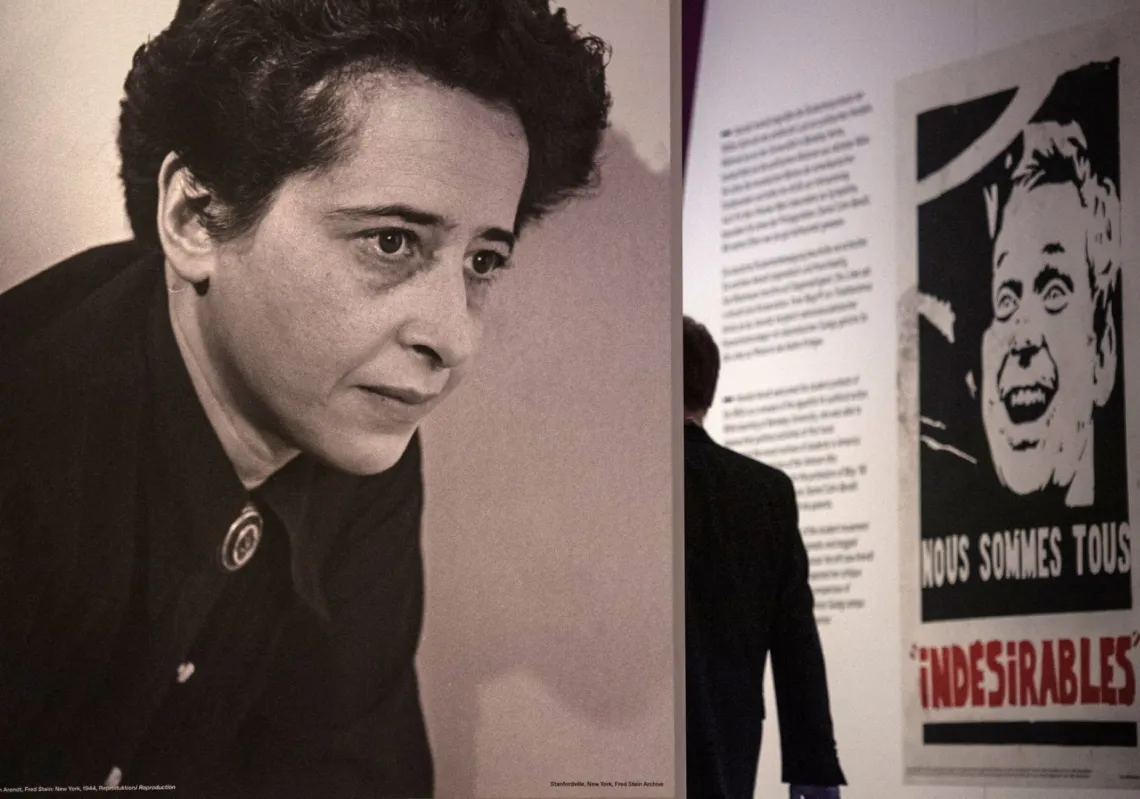 Mostafa El-Razzaz stands in front of one of his paintings at his latest exhibition, "Antara and Day Dreaming." (Ati Metwaly)[/caption]
Mostafa El-Razzaz stands in front of one of his paintings at his latest exhibition, "Antara and Day Dreaming." (Ati Metwaly)[/caption]
Renowned Egyptian artist Mostafa El-Razzaz is showcasing decades of artistic achievement with his latest solo exhibition, Antara and Day Dreaming, which opened at Cairo's Picasso Gallery on April 24. The exhibition consists of a series of paintings done by the artist over the years, all inspired by pre-Islamic knight and poet Antarah Ibn Shaddad. It is a fascinating retrospective revealing both Razzaz's intellectual wealth and his interest in linking ancient heritage with the present day.
"I always had this special affinity with Antarah. He is always welcomed in my paintings, sculpture, engravings . . . He comes and goes and knows he has a carte blanche," Razzaz tells The Majalla as he makes his way around his exhibition.
Born in Najd in 525 CE, Antarah is known for his courage, nobility and splendid poetry. His stories have inspired creative minds for centuries, and were both narrated orally and collected in autobiography-like anthologies. Antarah’s adventures showcase both his legendary bravery and his love for his cousin, Ablah. They come together to form a classical epic of a chivalrous romance that is also an exemplary portrayal of both the social and spiritual life of the pre-Islamic era.
Not only is Antarah an inspiration for many contemporary Middle Eastern artists and writers, he is also featured regularly in Arabic folk arts and crafts. Among the many known representations of Antarah are the traditional glass paintings by renowned Syrian artist Abu Subhi Al-Tinawi (1888–1973) and a series of paintings by the pioneering Lebanese artist Rafic Charaf (1932–2003).
Razzaz recalls the first time he encountered Antarah’s stories, in the 1960s. At that time, he was heavily influenced by his tutor, Saad El-Khadem (1913–1987), an Egyptian painter and heritage researcher. Khadem, Razzaz recalls of his master, was "a profound artist who managed to wed the folklore traditions with contemporary art."
Now in his 70s, Razzaz appreciates that his experience and passion for cultural research was largely inspired by his time with Khadem: his books on contemporary art, the hours they spent together going over unique manuscripts, and their long discussions about Egyptian people, their customs and stories.
Over an artistic career that has lasted half a century, Razzaz, who can be counted among the most notable Egyptian artists, has managed to create a vibrant link between the riches of the past and the realities of modern life. His many themes have included representations of Egyptian fisherwomen, as well as paintings of musicians—in particular oud players.
Antara and Day Dreaming captures the many different ways Antarah’s tales have influenced Razzaz, and this comes out in the variety of techniques and mediums used. "Collecting all those works in one exhibition was quite a challenge. I needed to find a unity in all the diversity," he explains.
The exhibition reveals Antarah to have been a constant theme in Razzaz's artistic development and creative experimentation—from monochromatic effects to the contrasting colors and works suffused with detail to more minimalist creations.
The minimal color and course texture of Razzaz’s early paintings of Antarah, from the 1960s, give a certain drama to his subject. Works from the end of the 1970s—the years after the artist’s return from his studies at the State University of New York—are characterized by a more direct and expressive language clearly influenced by the then-fashionable minimalist movement. In these paintings, Antarah loses his dramatic function and becomes part of a design dominated by sharp contrasts and striking phosphoric colors. "This focus on structure took me away from the emotional side of Antarah," the artist reveals as he moves on to show us his work from later decades. It is in this later work that he feels he managed to successfully fuse his previous explorations of theme, form and texture.
Razzaz also points to the social and political developments in Egypt in recent years as having influenced his latest paintings. "The revolutionary youth helped Egypt move a century forward," he says.
Antara and Day Dreaming showcases Razzaz’s artistic development, as he juggled between oils, acrylic and mixed-media, brisk, bright colors, texture paintings, and in one instance graffito technique, over nearly sixty years. And, though the Antarah portrayed in Razzaz’s 2014 painting is crude, this characterization represents the dynamics of the socio-political reality in Egypt that Razzaz is still trying to capture.
“Antara and Day Dreaming” will be showing at the Picasso Art Gallery in Cairo's Zamalek district until May 8, 2014.








